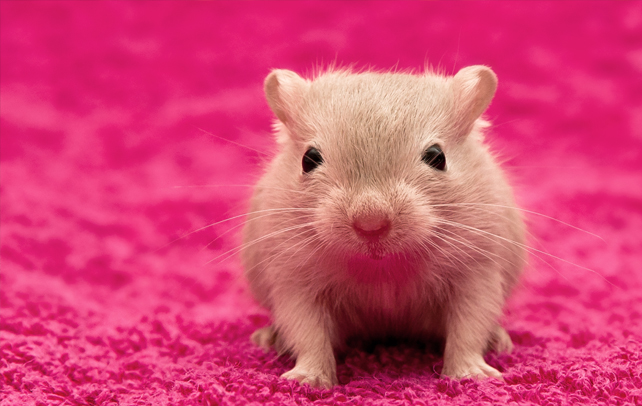Cool Facts About Gerbil

They are one of the cleanest of all the rodents, they are social animals and a good source of entertainment and their curious nature makes them popular pets, low maintenance too. They are the gerbils, and there are about 110 species of them, in their respective subfamilies of African, Indian and Asian rodents. Also known as old world rodents, as the word ‘gerbil’ is a diminutive form of ‘Jerboa’ (desert rodents found in Northern Africa and Asia), gerbils are quite adept to adapt in arid habitats. They live as much in the wild as they are popular as pets, for reasons described in the first line. Not to mention the cuteness inherent in them, and their miniature physique that makes them even cuddlier. In the following section, we have put together some interesting, amazing and fun facts about gerbil, to enlighten you with. Read on!
Fast Facts
Kingdom: Animalia
Phylum: Chordata
Class: Mammalia
Order: Rodentia
Superfamily: Muroidea
Family: Muridae
Subfamily: Gerbillinae
Body Length: 6-12 inches including the tail
Weight: 2 ½ ounce
Life Span: 2 to 3 years
Diet: Plant items like sunflower seeds, peanuts, fruits, and vegetables, along with insects
Habitat: Dry deserts, Woodland savannas and rocky mountain slopes
Age of Sexual Maturity: Males: 12 months; Females: 20-24 months
Gestation Period: 3 to 4 weeks
Litter Size: Anywhere between 1 and 13, Average is 4 to 7
Interesting And Fun Facts About Gerbil
- The Mongolian gerbils are popular as pets.
- Gerbils have a well developed kidney, they produce very less waste and are odourless and clean.
- Their fur is of a variety of colours, namely, brown, gray, cream and golden.
- One of their amazing habits is “thumping”. They do this with both hind legs when they are excited, while the young ones thump without any reason.
- Gerbil’s teeth continue to grow throughout their lives.
- Gerbils mark their territories by rubbing their stomachs on the nearby objects.
- To protect themselves from harsh temperatures, gerbils make their homes in burrows.
- The burrows of gerbils are designed with many tunnels so as to make enough room for food and nests.
- Gerbils are very adaptive to desert habitat; they drink less water and in turn sweat less.
- A male gerbil is called a hob while the female is called a jill. Their babies are called kits.
- Due to their social nature, two gerbils of the same sex should be kept together in pairs; a single one may feel depressed and become unhealthy.
- When kept as pets, gerbils should be provided with a nest box so as to make them feel secure.
- Out in the wild, gerbils live in groups and rely on their sense of smell to identify other members of the group.
- Gerbils take several naps during a day.
- Like every rodent, gerbils too carry rabies and various other diseases.
- If two stranger gerbils are kept together, they are highly likely to fight violently and can even kill each other. The duo, of the same sex, should be kept together from when they are young.
- The great gerbil, native to Central Asia, can grow as long as 20 cm, and resembles more to a squirrel.
- Plastic houses should be avoided as the gerbils have a knack of gnawing and can ingest plastic which can cause serious health injury.
- Birds, snakes and wildcats are some of its predators.
- Gerbils should not be picked up with their tail as their skin might detach.
- When compared to many other rodents, gerbils can run at a speed of six km per hour.
- The stomach portion of gerbils is generally in paler shades of gray, cream, or white. Some of them have whitish spots on their heads, especially behind the ears.
- Some species of gerbils breed all year long while others breed only seasonally.
- The litters are, on an average, of 4 to 7 and the gestation period lasts three to four weeks and the young ones are born blind and without any fur.
- Gerbils use different kinds of vocalizations: squeaks, grunts, clicking and high pitched grunts to communicate with each other. They also use pheromones to signal reproductive and social status.
- The gerbils eat nuts, fruits, vegetables. They can eat cheese, apple and carrot. Pumpkin seeds make a great treat for them.
- Though it may differ from species to species, the tail of a gerbil is as long as its body, which it uses to balance its body when standing on its hind legs.
- A gerbil comes to the ground from the burrows when it is hungry and thirsty.
- The pet gerbils should be kept clean and their homes should be cleaned often so as to keep them healthy and to prevent the diseases from spreading.
- The signs of illness in gerbils include laziness, dishevelled fur, mucus around the eyes and nose, and loss of appetite.
- As they protect the young, the females are known to be more aggressive than the females.
- If trained properly, gerbils can do some tricks and flips.









